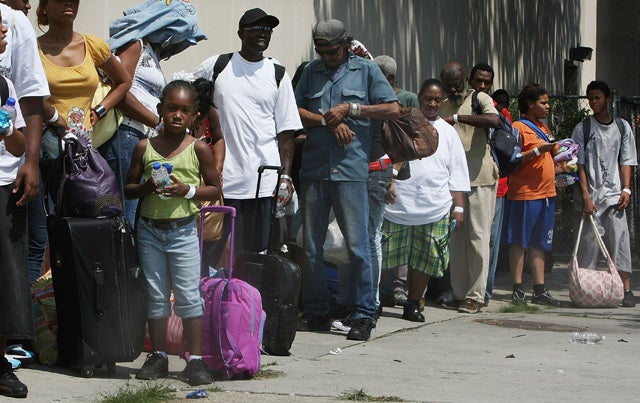Your support helps us to tell the story
From reproductive rights to climate change to Big Tech, The Independent is on the ground when the story is developing. Whether it's investigating the financials of Elon Musk's pro-Trump PAC or producing our latest documentary, 'The A Word', which shines a light on the American women fighting for reproductive rights, we know how important it is to parse out the facts from the messaging.
At such a critical moment in US history, we need reporters on the ground. Your donation allows us to keep sending journalists to speak to both sides of the story.
The Independent is trusted by Americans across the entire political spectrum. And unlike many other quality news outlets, we choose not to lock Americans out of our reporting and analysis with paywalls. We believe quality journalism should be available to everyone, paid for by those who can afford it.
Your support makes all the difference.Residents were ordered to flee an only partially rebuilt New Orleans today as another monster storm bore down on Louisiana nearly three years to the day after Hurricane Katrina wiped out entire swathes of the city.
Hurricane Gustav, which has already killed more than 80 people in the Caribbean, strengthened quickly into a Category 4 and was poised to become a Category 5 storm, packing winds in excess of 156 mph.
It slammed Cuba's tobacco-growing western tip before moving away from the island country into the Gulf of Mexico.
New Orleans Mayor Ray Nagin used stark language to urge residents to get out of the city, calling Gustav the "storm of the century".
"This is the real deal, not a test," Nagin said as he issued the evacuation order last night.
"For everyone thinking they can ride this storm out, I have news for you: that will be one of the biggest mistakes you can make in your life."
Forecasters were slightly less dire in their predictions, saying the storm should make landfall tomorrow afternoon somewhere between western Mississippi and East Texas, where evacuations were also under way. It is too early to know whether New Orleans will take another direct hit, they said, but city officials weren't taking any chances.
Gustav's centre was about 485 miles southeast of the Mississippi River's mouth at 0700 BST, with top winds of near 135mph expected to strengthen as it crosses the central Gulf. It was moving northwest near 15mph.
The mandatory evacuation of the city's west bank, where levee improvements remain incomplete, was to begin at 8am (1300 BST), with the east bank to follow at noon (1700 BST). It is the first test of a revamped evacuation plan designed to eliminate the chaos, looting and death that followed Katrina.
The city will not offer emergency services to those who choose to stay behind, Nagin said, and there will be no "last resort" shelter as there was during Katrina, when thousands suffered inside a squalid Superdome. The city said in a news release that those not on their property after the mandatory evacuation started would be subject to arrest.
Many residents didn't need to be ordered out, with an estimated one million people fleeing the Gulf Coast yesterday by bus, train, plane and car. They clogged roads, emptied petrol stations of fuel and jammed phone lines.
Homeland Security Secretary Michael Chertoff planned to travel to Louisiana today to observe preparations. And presidential nominee John McCain and his running mate, Alaska Governor Sarah Palin, were travelling to Mississippi.
Despite the stern warnings from Nagin and others, the expected arrival of 2,000 National Guard troops suggested officials were expecting stragglers.
Many residents said the early stage of the evacuation was more orderly than Katrina, although a plan to electronically log and track evacuees with a bar code system failed and was aborted to keep the buses moving. Officials said information on evacuees would be taken when they reached their destinations.
Some began arriving in Arkansas, where the National Guard prepared to shelter thousands for weeks. At least 15,000 people sought refuge in the inland state in 2005, following Katrina and Rita.
Meanwhile, as many as 500 critical-care patients were being airlifted from hospitals along the Gulf Coast to Dallas-Fort Worth International Airport, a spokesman said. The patients were being taken to hospitals around North Texas.

Join our commenting forum
Join thought-provoking conversations, follow other Independent readers and see their replies
Comments